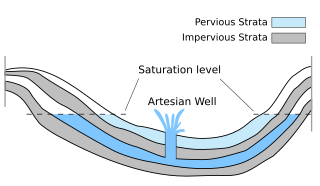
Jinan, formerly romanized as Tsinan, is the capital of Shandong province in Eastern China. The area of present-day Jinan has played an important role in the history of the region from the earliest beginnings of civilization and has evolved into a major national administrative, economic, and transportation hub. The city has held sub-provincial administrative status since 1994. Jinan is often called the "Spring City" for its famous 72 artesian springs.
Its population was 6.8 million at the 2010 census.

The Baotu Spring is a culturally significant artesian karst spring located in the city of Jinan, Shandong, China. It is mentioned in the Spring and Autumn Annals, one of the Five Classics of Chinese literature, and was declared the "Number One Spring under the Heaven" by the Qianlong Emperor in the Qing dynasty.

The Baimai Springs are a group of artesian karst springs located in Mingshui Subdistrict, Zhangqiu District, Jinan, Shandong Province, China about 25 kilometres west from the city centre of Jinan. The site of the springs is renowned for its natural beauty and as the one-time residence of the female Song Dynasty poet Li Qingzhao.
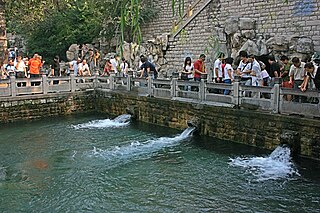
The Black Tiger Spring
(Chinese: 黑虎泉; pinyin: Hēi Hǔ Quán) is a culturally
significant artesian karst spring located in
the city of Jinan, Shandong Province,
China. The spring is ranked as the second most significant among
the 72 named springs in Jinan. The water
of spring stems from moderately-deep circulation and emerges from a water-filled limestone cave in a
steep cliff. From the mouth of the cave, the water is funneled to flow
out of the mouths of three ornamental stone-carved tiger heads into a
square-shaped spring pool. From there it runs into the old city moat,
next to which the spring is located. According to the tradition, there
was a black rock lying in front of the cave in ancient time. The name of the spring is
said to be derived from the shape and color of the rock, which
resembled a black tiger, and the sound of the water gushing past the
rock being reminiscent of the roar of a tiger. The ancient layout of
the spring is described in a poem by the Ming Dynasty poet, Yan
Bizeng.

The Pearl Spring is a culturally significant artesian karst spring located in the city of Jinan,
Shandong Province, China. The Pearl
Spring is located on the bottom of in a square spring pool that is
surrounded by a stone fence on all sides. The water flows off through
a canal into the Daming Lake. The spring was incorporated into the
garden of a governor in the year 1466 and the provincial government
continued to reside in vicinity of the spring until the 19th century
. The name of the
spring is said to be related to the bubbles forming in the spring.

The Five Dragon Pool is a
culturally significant pond fed by artesian
karst springs in the city of Jinan, Shandong
Province, China. It is one of the best known springs among the 72 famous springs of Jinan.

Que Hill is a small elongated hill located on the western shore of the Yellow River in the City of Jinan, Shandong Province, China. It is one of the solitary "Nine Hills" in the Yellow River valley within and to the north of Jinan City. Together with Hua Hill, which is today located on the opposite side of the Yellow River, Que Hill is depicted in a renowned painting by the Yuan-Dynasty era painter and calligrapher Zhao Mengfu entitled "Autumn Colors at Que and Hua Hills". The hill is positioned close to the northern end of the Luokou Yellow River Railway Bridge which was placed there because the hill stabilizes the course of the Yellow River. In November 1937, Japanese troops attacked the northern shore of the Yellow River and killed about 50 villagers who lived around Que Hill, the event became known as the Que Hill Tragedy.

Chengziya, also spelled Chengziyai, is a Chinese archaeological site and the location of the first discovery of the neolithic Longshan culture in 1928. The discovery of the Longshan culture at Chengziya was a significant step towards understanding the origins of Chinese civilization. Chengziya remains the largest prehistorical settlement found to date. The site is located in Shandong province, about 25 kilometres (16 mi) to the east of the provincial capital Jinan. It is protected and made accessible by the Chengziya Ruins Museum.
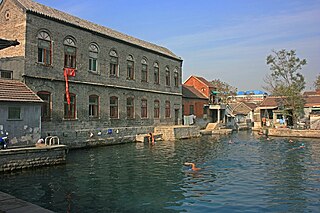
The Zhuoying Spring is a culturally significant artesian karst spring located in historical center of the city of Jinan, Shandong Province, China. It is listed among the 72 famous springs
(Chinese: 七十二名泉; pinyin: Qīshíèr Míng Quán) of Jinan. The spring forms a large spring pool, the Palace Pool, that is used as a public outdoor swimming pool.
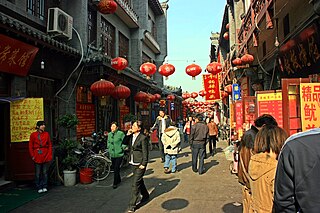
The Furong or Water Lily Street is a historical business street located in the central area of the old city of Jinan, Shandong, China. With a history that can be traced back for more than 2000 years, the street formerly served as the administrative, financial, commercial, and cultural center of the city.

The Liberation Pavilion is a monument commemorating the storming of the city of Jinan, Shandong by the People's Liberation Army during the Battle of Jinan in the Chinese Civil War. It stands in the inner south-eastern corner of the city moat near the site where the troops of People's Liberation Army breached the city wall on September 24, 1948. The city wall has since been removed.

The Zhejiang and Fujian Meeting Hall
(Chinese: 浙闽会馆; pinyin: Zhèmǐn Huìguǎn) is a historical Qing- Dynasty building in the City of Jinan, Shandong Province, China. It served as a meeting hall for traders form Zhejiang and Fujian living in Jinan and is the last remaining structure of its kind in the city. It illustrates the importance of Jinan as a trading center in the second half of the 19th century.
Jinan Olympic Sports Center is a sports venue in Jinan, China. It is located in the south-east of the city. The area is home to the main sports venues for the 2009 National Games of China in October 2009, including the main Jinan Olympic Sports Center Stadium. The entire precinct is 81 hectares in size.

The Guangzhi Yuan is a historical building in the City of
Jinan, Shandong Province, China. In the early 20th century, it
housed a museum that became the forerunner of the Shandong Provincial Museum.

Qushuiting Street (Chinese: 曲水亭街; pinyin: Qūshuǐtíng Jiē; literally: 'Winding water pavilion street' is a culturally significant alley in the
historical center of the City of Jinan, Shandong Province, China. The history of the street can be traced
back to the times of the Northern Wei Dynasty.

Laiwu is one of ten districts of the city of Jinan, Shandong province, China.
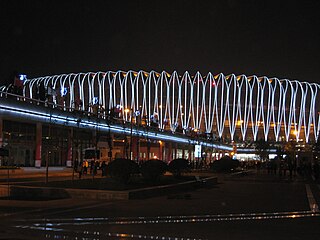
The Jinan Olympic Sports Centre Stadium, also colloquially known as Xiliu (西柳, literally: "West Willow")is a multi-use stadium in the Jinan Olympic Sports Center of Jinan, China. The stadium was the main venue for the 2009 National Games of China in October 2009. It was used for the opening ceremony, football matches and athletics events. The stadium has a capacity for 56,808 spectators at a construction area of 131,000 square metres and was opened in April 2009.

The Guandi Temple on Communist Youth League Street is a historical temple dedicated to Guan Yu in the Tianqiao district of Jinan, Shandong Province, China. It is one of the three best-preserved Guanyu temples in the area of Jinan, the other two are Guandi Temple in the Water Lily Street and in Xianxi Alley (县西巷).
The Ming Hu Ju is a theater that features primarily traditional performing arts from Shandong. It is located on the southern shore of the Daming Lake and to the north of the historical center of the city of Jinan, Shandong, China. The theater has been in operation since the late Qing dynasty. It was established in 1890 and its founding is attributed to the local artist Guo Dani (郭大妮). Besides the theater proper, the Ming Hu Ju also functions as a tea house and a restaurant. The Ming Hu Ju is featured as a setting in the novel The Travels of Lao Can by Liu E.



